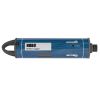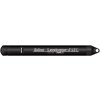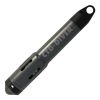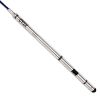Onset HOBO Salt Water Conductivity Logger
Features
- Non-contact sensor provides long life
- Provides easy access to sensor for cleaning and shedding air bubbles
- Requires HOBOware Pro Software and optic base station or waterproof shuttle
- Free ground shipping
- Expedited repair and warranty service
- Lifetime technical support
- More
Overview
The Onset HOBO U24-002-C is a cost-effective data logger for measuring salinity, conductivity and temperature in saltwater environments with relatively small changes in salinity (±5,000 μS/cm) such as saltwater bays, or to detect salinity events such as upwelling, rainstorm, and discharge events. Data from the logger can be used with data from the HOBO U26 Dissolved Oxygen Logger for monitoring percent dissolved oxygen saturation.
Note: When monitoring salinity in waters with more than ±5,000 uS/cm variation, refer to the accuracy shown in Plot C in the product specifications to determine if the accuracy is acceptable for your needs. Monthly field calibration readings are typically required to achieve the best accuracy.
Measurements: Actual Conductivity, Temperature, Specific Conductance at 25C (calculated), Salinity (calculated using PSS-78, the Practical Salinity Scale 1978)
Conductivity Measurement Range (Calibrated Range)
High range: 5000 to 55,000 uS/cm
Low range: 100 to 10,000 uS/cm
Over the range of 5 to 35C (41 to 95F)
Temperature Measurement Range: 5 to 35C (41 to 95F)
Specific Conductance Accuracy (in Calibrated Range using Conductivity Assistant and Calibration Measurements)
Low range: 3% of reading or 50 µS/cm, whichever is greater
High range: 5% of reading, in waters within a range of ±3,000 µS/cm; waters with greater variation can have substantially greater error (see Plot C)
Conductivity Resolution: 2 uS/cm
Temperature Accuracy: 0.1°C (0.2°F) at 25°C (77°F)
Temperature Resolution: 0.01°C (0.02°F)
Conductivity drift: Up to 12% sensor drift per month, exclusive of drift from fouling. Monthly start- and end-point calibration should be used with the HOBOware Conductivity Assistant to achieve the specified Specific Conductance accuracy.
Response time: 1 second to 90% of change (in water)
Operating range: -2 to 36C (28 to 97F) – non-freezing
Memory: 18,500 temperature and conductivity measurements when using one conductivity range; 11,500 sets of measurements when using both conductivity ranges (64 KB total memory)
Sample rate: 1 second to 18 hrs, fixed or multiple-rate sampling with up to 8 user-defined sampling intervals
Clock accuracy: +/- 1 minute per month
Battery life: 3 years (@ 1 min logging)
Maximum depth: 70 m (225')
Weight: 193 gm (6.82 ounces), buoyancy in freshwater: -59.8 gm (-2.11 ounces)
Size: 3.18 cm diameter x 16.5 cm, with 6.3 mm mounting hole (1.25" diameter x 6.5", ¼" hole)
Wetted housing materials: Delrin housing, epoxy, stainless steel retaining ring, polypropylene, Buna rubber O-ring, titanium pentoxide (inert coating over sensor) – all materials are suitable for long-term use in saltwater.
- HOBO U24-002-C Conductivity Data Logger
- Communications window protective cap
In The News
Sustainable Fishing in Alaska: Protecting the Salmon Capital of the World through Research
In the far north, the Alaska Peninsula stretches away from the Last Frontier into the Pacific Ocean. A narrow strip of land dotted with freshwater lakes and intruded upon by ocean inlets–this unique region is intimately connected with the surrounding water. Nestled halfway down the peninsula's southern coast are the small villages of Chignik. The area has historically been home to the Aleut people and has been heavily reliant on fishing for centuries. Home to commercial and subsistence fishing today, Chignik continues to rely upon the salmon returns to the surrounding villages, which are supported by scientists working tirelessly to understand and steward these fish populations.
Read MoreNexSens X3 Data Logger Review
Extreme environments meet extreme design with the NexSens X3 Data Logger . The new logger offers the latest in real-time monitoring technology with wireless communication, a large plug-and-play sensor library and ultra-low power consumption, all in a waterproof marine-grade housing. The X3 is built to handle harsh weather, floods, high winds and rough seas, and it stands alone; no additional protective housing needed. With an operating temperature that ranges from -40°C to 70°C, the logger can withstand arctic environments and extreme heat. A conformal coating on the internal circuit board isolates it from moisture and humidity.
Read MoreBuoy-Based Solutions: Strengthening Kentucky’s Emergency Response Efforts
When Kentucky’s Emergency Response Team (ERT) has to act quickly in response to chemical and oil spills in the Commonwealth, they rely on small, easily deployable buoys to collect critical data that help minimize and evaluate damages in environmental emergencies. With a background in geology, Robert Blair primarily worked with groundwater and got involved sporadically with the ERT during groundwater contamination emergencies. Over time, this involvement led to him joining the ERT as an On-Scene Coordinator and then becoming the branch manager for the team and overall Emergency Response Branch .
Read More
















